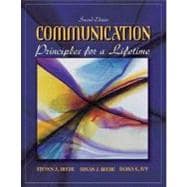
Note: Supplemental materials are not guaranteed with Rental or Used book purchases.
Purchase Benefits
Looking to rent a book? Rent Communication : Principles for a Lifetime [ISBN: 9780205386970] for the semester, quarter, and short term or search our site for other textbooks by Beebe, Steven A.; Beebe, Susan J.; Ivy, Diana K.. Renting a textbook can save you up to 90% from the cost of buying.
Each chapter concludes with “Summary.”
I. PRINCIPLES OF COMMUNICATION.
1. Foundations of Human Communication.
Communication Defined.
Why Study Communication?
Communication Models.
Communication Characteristics.
Communication Principles for a Lifetime.
Communicating with Others: Three Situations.
2. Self-Awareness and Communication.
Self-Concept: Who Are You?
Self-Esteem: What Is Your Value?
Communication and the Enhancement of Self-Esteem.
The Perception Process.
Communication and the Enhancement of Perceptual Accuracy.
3. Understanding Verbal Messages.
Why Focus on Language?
The Nature of Language.
The Power of Words.
Confronting Bias in Language.
Using Words to Establish Supportive Relationships.
4. Understanding Nonverbal Messages.
Why Focus on Nonverbal Communication?
The Nature of Nonverbal Communication.
The Multichanneled Nature of Nonverbal Communication.
Codes of Nonverbal Communication.
How to More Accurately Interpret Nonverbal Cues.
5. Listening and Responding.
How We Listen.
Listening Barriers.
Listening Skills.
Responding Skills.
Responding with Empathy.
6. Adapting to Others: Bridging Culture and Gender Differences.
Culture and Communication.
Gender and Communication.
Barriers to Bridging Differences and Adapting to Others.
Adapting to Others Who Are Different from You.
II. INTERPERSONAL COMMUNICATION.
7. Understanding Interpersonal Communication.
What Is Interpersonal Communication?
Initiating Relationships.
Maintaining Relationships through Interpersonal Communication.
8. Enhancing Relationships.
The Importance of Friendship.
The Importance of Family.
The Importance of Colleagues.
Stages of Relationship Development.
Managing Interpersonal Conflict.
III. COMMUNICATING IN GROUPS AND TEAMS.
9. Understanding Group and Team Performance.
Groups and Teams Defined.
Understanding Types of Groups and Teams.
Understanding Group and Team Dynamics.
Understanding Group and Team Phases of Development.
Understanding Diversity in Groups and Teams: Adapting to Differences.
10. Enhancing Group and Team Performance.
What Effective Group Members Do.
Structuring Group and Team Problem Solving.
Enhancing Team Leadership.
Enhancing Group and Team Meetings.
IV. PRESENTATIONAL SPEAKING.
11. Developing Your Presentation.
An Overview of the Presentational Speaking Process.
Understanding Speaker Anxiety.
Managing Speaker Anxiety.
Selecting and Narrowing Your Topic.
Identifying Your Purpose.
Developing Your Central Idea.
Generating Main Ideas.
Gathering Supporting Material.
12. Organizing and Outlining Your Presentation.
Organizing Your Main Ideas.
Organizing Your Supporting Material.
Organizing Your Presentation for the Ears of Others.
Introducing and Concluding Your Presentation.
Outlining Your Presentation.
13. Delivering Your Presentation.
Methods of Delivery.
Effective Verbal Delivery.
Effective Nonverbal Delivery.
Effective Presentation Aids.
Some Final Tips for Rehearsing and Delivering Your Presentation.
14. Speaking to Inform.
Types of Informative Presentations.
Strategies for Making Your Informative Presentation Clear.
Strategies for Making Your Informative Speech Interesting.
Strategies for Making Your Presentation Memorable.
15. Speaking to Persuade.
Persuasion Defined.
Motivating Your Audience: The Psychology of Persuasion.
Selecting and Narrowing Your Persuasive Topic.
Identifying Your Persuasive Purpose.
Developing Your Central Idea as a Persuasive Proposition.
Supporting Your Presentation with Credibility, Logic, and Emotion: Strategies for Persuading Your Audience.
Organizing Your Persuasive Message.
How to Adapt Ideas to People and People to Ideas.
Appendix A. Interviewing.
Appendix B. Sample Speeches for Discussion and Evaluation.
The New copy of this book will include any supplemental materials advertised. Please check the title of the book to determine if it should include any access cards, study guides, lab manuals, CDs, etc.
The Used, Rental and eBook copies of this book are not guaranteed to include any supplemental materials. Typically, only the book itself is included. This is true even if the title states it includes any access cards, study guides, lab manuals, CDs, etc.